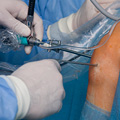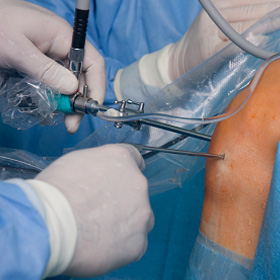
An arthroscopy being performed on a knee joint.
The basics Arthroscopy is a test that allows your doctor to examine the inside of your joint using a thin instrument called an arthroscope. Arthroscopy may be used to view joint surfaces and surrounding tissues to diagnose a joint problem, to treat a joint problem, or to monitor the progression of joint conditions.
Joint problems that may be treated by this procedure may include bone fragmentation, damaged or torn cartilage or ligaments, inflamed joint linings, joint infections, or scarring within the joints.
Your doctor will decide how often you may need this test. An arthroscopy may be performed on the knee, shoulder, elbow, ankle, hip, or wrist.
Risks and precautionsArthroscopy is sometimes done under general anesthesia. In general, surgery and the use of anesthesia come with some risks that are associated with factors like your health and what the surgery involves. Side effects are very rare but can include trouble breathing, reactions to the anesthetic, bleeding, infection, scarring, and death.
Arthroscopy is usually a straightforward and safe procedure. However, there are some risks of complications or side effects, including:
- bleeding
- infection (fever, chills, welling, redness, pus, swollen lymph node, and warmth around the joint)
- blood clot in the limb
- damage to the nerves, the joint, or the tissues around the joint
- pressure buildup in muscle (compartment syndrome)
Get immediate medical assistance if you experience any of these complications or side effects.
It is important that you understand all the risks of complications and side effects of the test, and what you or your doctor can do to avoid them. Make sure that your doctor is aware of all your concerns.
Some people may experience complications or side effects other than those listed. Check with your doctor if you notice any symptom that worries you after your procedure.
During the testThis test is often done in a hospital or clinic by a surgeon that specializes in this area. Depending on the joint being tested, you may receive general, regional, or local anesthesia.
- The joint being examined will be stabilized.
- Your doctor may place a band around the joint area to limit blood flow to the joint.
- Your doctor will make a small incision in the skin to insert the arthroscope. A camera is attached to the arthroscope to display the inside of a joint on a screen.
- Your doctor may make additional incisions into the skin to allow the entry of surgical tools as needed to repair any damage.
- The small incisions are closed with stitches.
This procedure usually takes between 30 minutes to 2 hours.
Before the testIt is important that you fully understand what the test involves beforehand. Ask your doctor to explain the risks, benefits, and drawbacks of the test, and don't be shy to probe further until you are comfortable with your doctor's responses.
You should let your doctor know if you may be pregnant, have any medical conditions or have injured the joint being examined in the past.
You may not be able to eat or drink before the procedure; follow the timing that your doctor recommends. In general, people are advised to not eat for 8 hours before the procedure and most hospitals ask that you do not drink or eat anything after midnight the night before the procedure.
If you are taking any prescription or over-the-counter (non-prescription) medications, supplements, or herbal products, make sure you inform your doctor or pharmacist. Ask them whether it is necessary for you to stop taking any of these medications and products before the test. It is also important to tell them if you have allergies to certain medications, bandages, latex or have other medical conditions.
Plan to have someone drive you home after the test.
After the testIt is normal to experience some pain and tenderness around the joint after the procedure. You may need to rest your joint for a few days and use ice, compression, and elevation of the joint to reduce any discomfort. You may or may not have to use splints, slings, or crutches after the procedure.
Your doctor may give you antibiotics to prevent infection and pain-relieving medications. You should try to keep the bandage that covers your wound as dry as possible. It can take anywhere from a few weeks to several weeks for your joint to heal.
If you were given general anesthesia before the surgery, you will be assigned to a hospital recovery room immediately after the surgery. As the anesthesia wears off, you may feel sore, groggy, or nauseous. Nurses will be available to assist you.
After the anesthetic wears off, you will either be discharged from the hospital or required to stay overnight, at which point you will be moved to a regular ward for the rest of your stay. Before you are discharged, the doctor or nurse will explain the steps you need to take to complete your recovery at home.
Your doctor should be able to review the results of the test with you right away. You will most likely have follow-up visits with your doctor to assess how well your joint is healing.

An arthroscopy being performed on a knee joint.